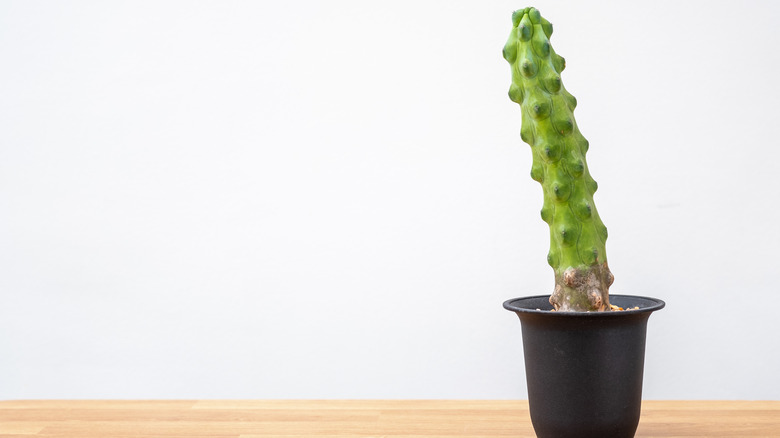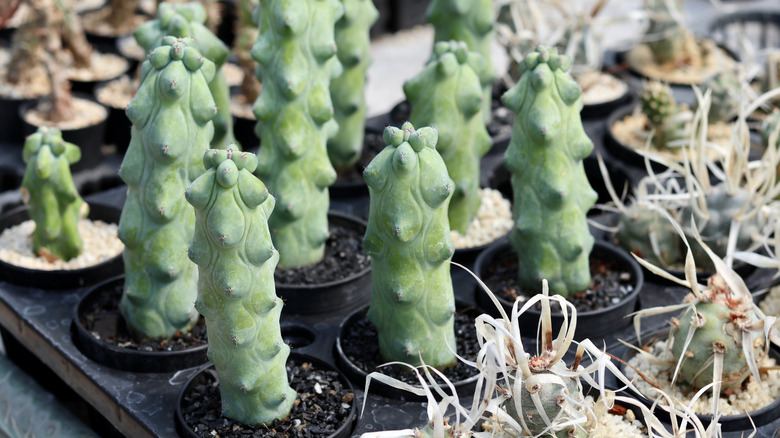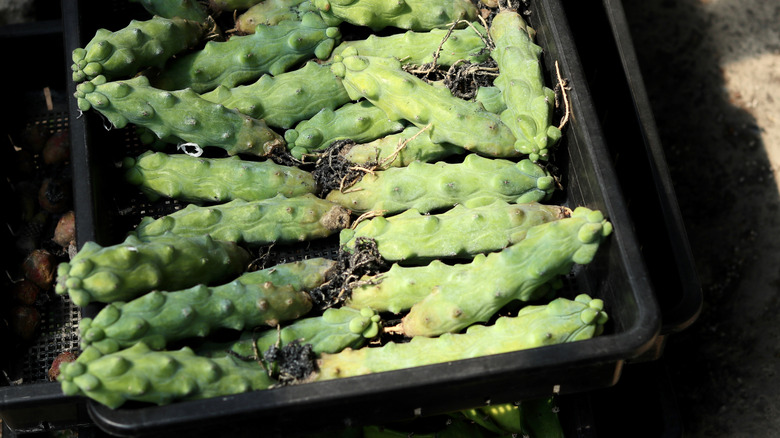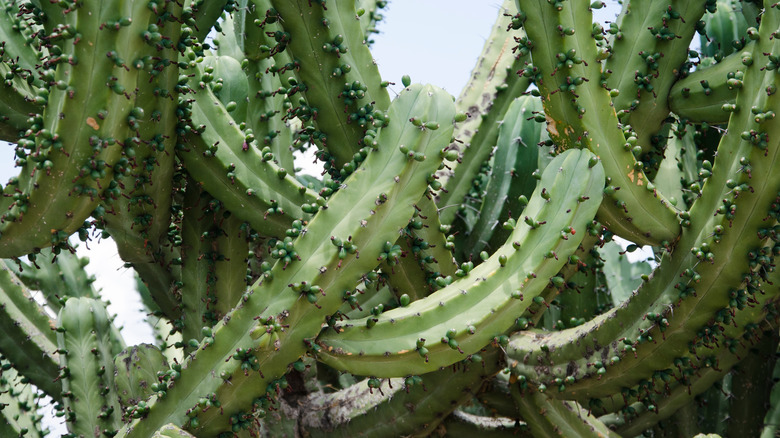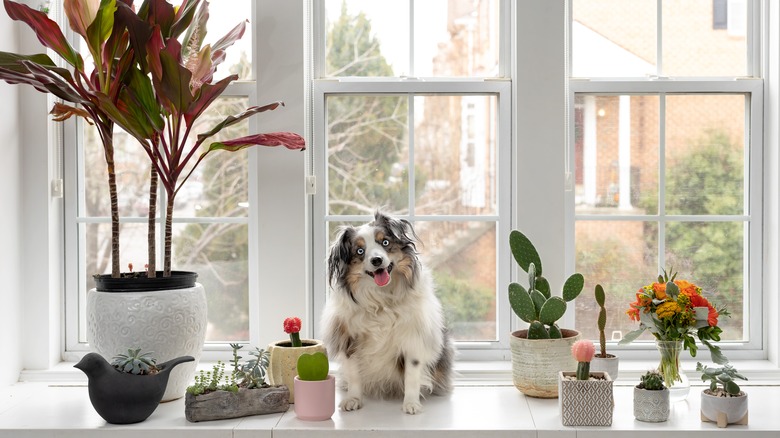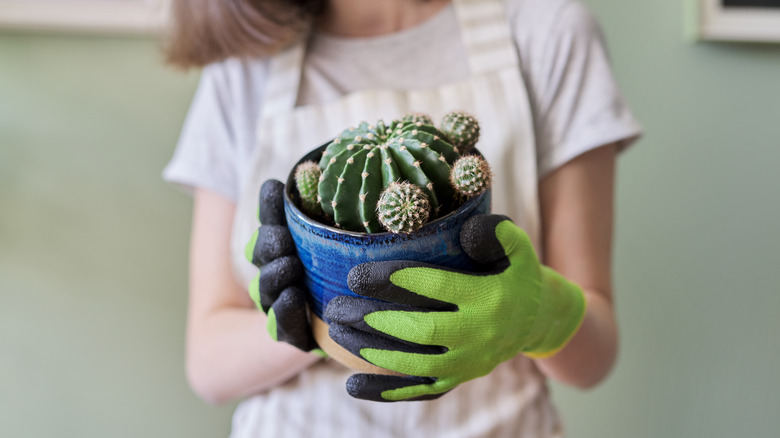How To Care For A Boobie Cactus
There has never been a more appropriate moniker for a pant than that of the boobie cactus (Myrtillocactus geometrizans 'Fukurokuryuzinboku'), also called a Blue Candle Cactus. This perky little plant has a thick green pillar-like stem that is tinted with blue, and its ribs are shaped like a woman's breasts. At maturity, the boobie cactus can grow to a height of 24 inches. The white flowers sprout from the areoles and are about an inch and a half in diameter. Each areole also sprouts three to five spikes on average but can sprout as many as nine from each areole.
According to World of Succulents, the boobie cactus, a relatively rare but highly popular succulent, is a Japanese nursery cultivar, meaning they don't occur naturally in the wild. The Myrtillocactus geometrizans that it originates from, however, is native to northern Central Mexico. While the parent family can happily live outside in gardens in zones 9a to 10b, the boobie cactus cultivar is specifically purchased as an indoor plant.
How to grow a boobie cactus
The Spruce mentions the boobie cactus is frequently spotted in garden centers. Their popularity and unique physical appearance make them coveted by plant collectors, but it's still easier to purchase than grow on your own. Because the boobie cactus is a cultivar and does not occur naturally, it can only be grown through the propagation of a cutting. If you were to collect and germinate the seeds, they will only produce the naturally Myrtillocactus geometrizans cactus and won't have the breast-like protrusions, explains Desert Plants of Avalon.
It is best to take a cutting anytime during its growing season, between early Spring and mid-Summer. Do not take cuttings in winter or colder months. If the cutting is not taken when the temperature is at least 65 degrees Fahrenheit, the cutting will not grow roots. Before planting your cutting in well-draining soil, allow it to form a full callus over the site of cutting. Depending on the humidity and temperature conditions, this can take up to two weeks. To encourage maximum drainage, add a layer of gravel or pebbles to the bottom of your pot before adding the dirt, suggests World of Succulents. You can also mix in extra sand or perlite to add to the aeration.
How to care for a boobie cactus
The boobie cactus, like any other succulent, is relatively easy to care for thanks to their hardy nature. Water regularly during the spring and summer months, but keep the soil dry in winter months, watering just enough so the plant does not shrivel. During growing season, the boobie cactus should be kept in a location with plenty of direct sunlight. Move the plant at the start of winter to a location with bright indirect light to allow it to go dormant.
World of Succulents suggests feeding your boobie cactus once every three weeks during spring and summer with a fertilizer specifically designed for cacti. If you can't find a cactus fertilizer, Gardening Know How recommends diluting a houseplant fertilizer by half. Any houseplant fertilizer would work perfectly fine this way, just make sure that is higher in phosphorous than nitrogen, such as a 5-10-5 solution. You will not need to fertilize your boobie cactus over the winter months.
Boobie cactus varieties
The boobie cactus is a cultivar, meaning it is specifically designed by humans to be sold in garden centers that specialize in creating them. They are not found naturally in the wild, and plants that germinate from their seeds revert to the features of the parent plant: the Myrtillocactus geometrizans, also known as the blue candle or blue myrtle cactus.
Horticulture Unlimited inc. describes the bilberry cactus as being shaped like a candelabra. Like the boobie cactus derived from it, the blue myrtle cactus has thick green stalks that are tinted with blue. Each stem has several areoles that produce three to five spikes and white flowers that eventually turn dark red right before it produces fruit. While the boobie cactus could grow to a maximum of 24 inches, the blue myrtle cactus can reach a height of 11 to 15 feet and can spread to be 6 to 10 feet wide.
Is the boobie cactus toxic?
The Myrtillocactus geometrizans, as well as its boobie cactus cultivar, are not known to be toxic to humans or pets. In fact, the berries from the blue myrtle cactus, called garambullos, are often harvested from the wild and sold in markets in Mexico. They are deep red in color and have a sweet taste similar to blueberries. They can be eaten fresh or dried in the same manner as raisins or cranberries. According to The University of Arizona, the garambullos have long been considered an essential part of diets of many native groups, such as the Apache, Ute, Papago, and Tewa.
Even though this plant is not toxic to dogs or cats and the fruits are delicious, it's best to keep the plant out of reach because the cactus itself can still be dangerous. The plant has many thorns that could cause injury or get caught in the throat or mouth if an animal tries to eat the plant.
How to repot a boobie cactus
Because of its fast-growing rate, the boobie cactus will likely need to be repotted every other year, or perhaps even every year, depending on how quickly it outgrows the container, says World of Succulents. The good news is that it will be perfectly happy in any of the store-bought potting mediums that are designed for cacti. You can also mix your own potting soil by mixing equal parts potting mix and sand, perlite, or vermiculite.
To remove the cactus from its old pot without getting stabbed, use gloves or tongs to safely lift the plant from its container, suggests Gardening Know How. Shake the old soil from the boobie cactus roots and place it in the new container. Fill the surrounding area of the new pot with the new potting medium but make sure to plant the boobie cactus at the same depth that it was being held in the previous container. Wait a few weeks before watering instead of watering the cactus immediately after repotting. The repotting process is stressful for cacti, and they need more time to get acclimated to their new soil and container after being handled.
